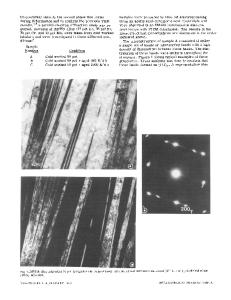Automated Crystallite Orientation and Phase Mapping in a Transmission Electron Microscope
- PDF / 356,761 Bytes
- 6 Pages / 432 x 648 pts Page_size
- 50 Downloads / 445 Views
Automated Crystallite Orientation and Phase Mapping in a Transmission Electron Microscope Sergei Rouvimov1,2, Peter Moeck1, Ines Häusler3, Wolfgang Neumann2,3, and Stavros Nicolopoulos4 1 Department of Physics, Portland State University, Portland, OR 97207-0751, U.S.A. & Oregon Nanoscience and Microtechnologies Institute, www.onami.us 2 Department of Chemistry, University of Oregon, Eugene, OR 97401-3753, U.S.A. & Oregon Nanoscience and Microtechnologies Institute 3 Institute of Physics, Humboldt University of Berlin, Newtonstreet 15, 12489 Berlin, Germany 4 NanoMEGAS SPRL, Boulevard Edmond Machterns No 79, Saint Jean Molenbeek, Brussels, B-1080, Belgium, nanomegas.com
ABSTRACT An automated technique for the mapping of nanocrystal phases and orientations in a transmission electron microscope (TEM) is briefly described. It is primarily based on the projected reciprocal lattice geometry that is extracted automatically from precession electron diffraction (PED) enhanced spot patterns. The required hardware allows for a scanning-precession movement of the primary electron beam on the crystalline sample and can be interfaced to any newer or older mid-voltage TEM. Comprehensive open-access crystallographic databases that may be used in support of this technique are mentioned. INTRODUCTION The electron backscattered diffraction (EBSD) technique (which is also known as orientation imaging microscopy) in a scanning electron microscope (SEM) [1] is often employed for structural characterization of polycrystalline materials. EBSD in a SEM is based on back-scattered Kikuchi diagrams. It is therefore sensitive to the plastic deformation state of the crystallites as well as to structural damage or contamination of the crystal surfaces. The spatial resolution of this technique ranges from 20 to 80 nm [1,2]. There are also ongoing efforts to develop orientation imaging microscopy in a transmission electron microscope (TEM) [2,3]. That technique is marketed as “Automated Crystallography for the TEM” (ACT) by TSL-EDAX and works on the basis of some 5,000 automatically collected conical dark field images. In the fall of 2008, an alternative automated electron diffraction system for orientation imaging in the TEM has been demonstrated for the first time [4]. Heavily deformed Cu foils with grain sizes on the order of 20 nm were used as examples. The utilization of the PED mode [5,6] proved crucial to the success of the automated procedure on these samples. This electron diffraction technique is based on template matching of experimentally obtained electron diffraction spot patterns to their pre-calculated theoretical counterparts. Such template matching has been utilized off line for the crystallographic characterization of precipitates in heavily deformed austenitic stainless steels [7,8] and shown to be a very robust procedure. The new technique produces crystallite orientation and phase map also for plastically deformed polycrystalline materials (which do not produce back-scattered Kikuchi lines of a sufficient quality in an SEM). A
Data Loading...











